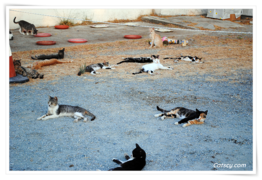
THE ONGOING STRUGGLE TO HELP THE FERAL AND STRAY CATS OF CYPRUS!
Cyprus! A sunny, peaceful, Mediterranean island with pristine beaches, scenic mountains, and a rich history of ancient monuments and relics. The residents enjoy a relaxed pace of life and excellent standards of living—at least, for humans. For the nearly 1.1 million feral and stray cats roaming the streets, the reality is quite different.
The story of cats in Cyprus goes far deeper than legend. While it’s said that St. Helene brought cats to the island to hunt the poisonous snakes that once plagued Cyprus—a tale that still endures—archaeological discoveries have revealed an even older bond between felines and Cypriots. In fact, Cyprus is home to the oldest known remains of a domesticated cat, found buried alongside a human in a Neolithic grave dating back nearly 9,500 years. This astonishing find highlights just how long cats have shared their lives—and survival—with people on the island.
Yet despite this ancient relationship, today’s descendants of those heroic snake hunters face significant challenges. The inadequate annual government funding for sterilization coupled with Cyprus’s favorable climate—where a female cat can give birth up to three times a year—has led to a chronic overpopulation crisis. Their numbers swell on sun-drenched streets and in forgotten rural corners, each cat searching for food, shelter, and a safe place to rest.
Animal lovers across Cyprus are working tirelessly with limited resources to feed, heal, nurse, and neuter as many cats as possible. Their compassion is a modern echo of the island’s long and intertwined history with its feline companions—striving to protect and care for those who have been a part of Cyprus’s story since the dawn of civilization.
If you want to help make a difference, simply clicking on certain ads supports their efforts—every little bit helps the stray cats find safer, healthier lives.








